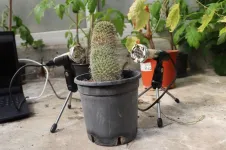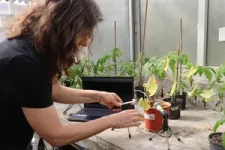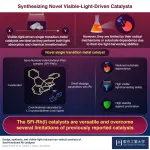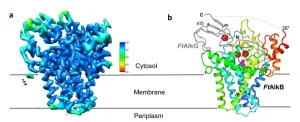(Press-News.org) The sounds emitted by plants are ultrasonic, beyond the hearing range of the human ear.
Plant sounds are informative: mostly emitted when the plant is under stress, they contain information about its condition.
The researchers mainly recorded tomato and tobacco plants; wheat, corn, cactus, and henbit were also recorded.
The researchers: "Apparently, an idyllic field of flowers can be a rather noisy place. It's just that we can't hear the sounds!"
Global breakthrough: for the first time in the world, researchers at Tel Aviv University recorded and analyzed sounds distinctly emitted by plants. The click-like sounds, similar to the popping of popcorn, are emitted at a volume similar to human speech, but at high frequencies, beyond the hearing range of the human ear. The researchers: "We found that plants usually emit sounds when they are under stress, and that each plant and each type of stress is associated with a specific identifiable sound. While imperceptible to the human ear, the sounds emitted by plants can probably be heard by various animals, such as bats, mice, and insects."
Link to the research video
https://www.youtube.com/watch?v=hOWaXi0I2YE
The study was led by Prof. Lilach Hadany from the School of Plant Sciences and Food Security at the Wise Faculty of Life Sciences, together with Prof. Yossi Yovel, Head of the Sagol School of Neuroscience and faculty member at the School of Zoology and the Steinhardt Museum of Natural History, and research students Itzhak Khait and Ohad Lewin-Epstein, in collaboration with researchers from the Raymond and Beverly Sackler School of Mathematical Sciences, the Institute for Cereal Crops Research, and the Sagol School of Neuroscience – all at Tel Aviv University. The paper was published in the prestigious scientific journal Cell.
Prof. Hadany: "From previous studies we know that vibrometers attached to plants record vibrations. But do these vibrations also become airborne soundwaves - namely sounds that can be recorded from a distance? Our study addressed this question, which researchers have been debating for many years."
At the first stage of the study the researchers placed plants in an acoustic box in a quiet, isolated basement with no background noise. Ultrasonic microphones recording sounds at frequencies of 20-250 kilohertz (the maximum frequency detected by a human adult is about 16 kilohertz) were set up at a distance of about 10cm from each plant. The study focused mainly on tomato and tobacco plants, but wheat, corn, cactus and henbit were also recorded.
Prof. Hadany: "Before placing the plants in the acoustic box we subjected them to various treatments: some plants had not been watered for five days, in some the stem had been cut, and some were untouched. Our intention was to test whether the plants emit sounds, and whether these sounds are affected in any way by the plant's condition. Our recordings indicated that the plants in our experiment emitted sounds at frequencies of 40-80 kilohertz. Unstressed plants emitted less than one sound per hour, on average, while the stressed plants – both dehydrated and injured – emitted dozens of sounds every hour."
The recordings collected in this way were analyzed by specially developed machine learning (AI) algorithms. The algorithms learned how to distinguish between different plants and different types of sounds, and were ultimately able to identify the plant and determine the type and level of stress from the recordings. Moreover, the algorithms identified and classified plant sounds even when the plants were placed in a greenhouse with a great deal of background noise. In the greenhouse the researchers monitored plants subjected to a process of dehydration over time and found that the quantity of sounds they emitted increased up to a certain peak, and then diminished.
Prof. Hadany: "In this study we resolved a very old scientific controversy: we proved that plants do emit sounds! Our findings suggest that the world around us is full of plant sounds, and that these sounds contain information – for example about water scarcity or injury. We assume that in nature the sounds emitted by plants are detected by creatures nearby, such as bats, rodents, various insects, and possibly also other plants - that can hear the high frequencies and derive relevant information. We believe that humans can also utilize this information, given the right tools - such as sensors that tell growers when plants need watering. Apparently, an idyllic field of flowers can be a rather noisy place. It's just that we can't hear the sounds!"
In future studies the researchers will continue to explore a range of intriguing questions: What is the mechanism behind plant sounds? How do moths detect and react to sounds emitted by plants? Do other plants also hear these sounds? And more…
Link to the article:
https://doi.org/10.1016/j.cell.2023.03.009
END
March 30, 2023 – The American Thoracic Society has issued an official statement for clinicians that explains why race and ethnicity should no longer be considered factors in interpreting the results of spirometry, the most commonly used type of pulmonary function test (PFT). The statement was endorsed by the European Respiratory Society. The full statement is available online in the American Journal of Respiratory and Critical Care Medicine.
Spirometry is a breathing test that measures how much air is going into an individual’s lungs, and how rapidly air is inhaled and exhaled. ...
CHAMPAIGN, Ill. — For the first time, researchers have observed the process of nanoparticles self-assembling and crystalizing into solid materials. In new videos produced by the team, particles can be seen raining down, tumbling along stairsteps and sliding around before finally snapping into place to form a crystal’s signature stacked layers.
Led by Qian Chen at the University of Illinois Urbana-Champaign and Erik Lutijen at Northwestern University, the study used liquid-phase transmission electron microscopy and computational modeling to gain an unprecedented view of the self-assembly ...
On bright chilly mornings you can either snuggle down under the duvet or leap up and seize the day.
However, for photosynthesising plants, this kind of dawn spells danger, so they have evolved their own way of making cold mornings tolerable.
Research led by the John Innes Centre has discovered a cold “coping” mechanism that is under the control of the plant biological clock and could offer solutions to breeding more resilience into crops less suited to cold climates.
“We’ve identified a new process that helps plants ...
Worcester, Mass. – March 30, 2023 – A new study led by Worcester Polytechnic Institute (WPI) brings into sharper focus the structural details of the COVID-19 virus, revealing an elliptical shape that “breathes,” or changes shape, as it moves in the body. The discovery, which could lead to new antiviral therapies for the disease and quicker development of vaccines, is featured in the April edition of the peer-reviewed Cell Press structural biology journal Structure.
“This is critical knowledge we need to fight future pandemics,” said Dmitry Korkin, Harold L. Jurist ’61 and Heather E. Jurist Dean’s ...
CLEVELAND – A study published in the March 30 issue of the New England Journal of Medicine has shown that there may finally be an alternative to amputation for patients suffering from chronic limb-threatening ischemia (CLTI), the most severe form of peripheral artery disease. This study, co-led by University Hospitals (UH) Harrington Heart & Vascular Institute, could lead to the first FDA approval of a therapy giving thousands of patients hope for an alternative to limb loss.
THERAPY SAVES MOST PATIENTS FROM AMPUTATION
The PROMISE II U.S. pivotal clinical trial found that minimally ...
NEW YORK, NY (March 30, 2023)--With a transformational gift from the Bezos Family Foundation, Columbia will launch the Center for the Transition to Parenthood (TtP) in the Department of Obstetrics and Gynecology (Ob/Gyn). Supported by the most advanced scientific knowledge in the field, the TtP Center seeks to reinvent prenatal care, address the mental health of parents, improve the overall health of their infants, and promote family well-being.
The Center, established with a gift of $21 million from the Bezos Family Foundation, will develop, test, and put into practice a range ...
Shigella bacteria can infect humans but not mice. In the March 29 issue of Nature, a team from UConn Health explains why. Their findings may explain the multifariousness of a key weapon of our immune system.
Shigella infections cause fever, stomach pain, and prolonged, sometimes bloody diarrhea for as long as a week. The bacteria sicken 450,000 people each year in the US alone. Although most people recover on their own, children and those with weakened immune systems are at risk of Shigella ...
An international team of researchers, led by Drexel University, has found that a thin coating of MXene — a type of two-dimensional nanomaterial discovered and studied at Drexel for more than a decade — could enhance a material’s ability to trap or shed heat. The discovery, which is tied to MXene’s ability to regulate the passage of ambient infrared radiation, could lead to advances in thermal clothing, heating elements and new materials for radiative heating and cooling.
The group, including materials science ...
Photocatalysis is the use of light to accelerate the rate of a reaction in the presence of a photocatalyst. The catalyst plays a crucial role in this process—it absorbs the light being shined onto it and makes it available in way that can help accelerate the chemical reaction and also enhance it. These catalysts are used for a variety of light-dependent reactions ranging from the production of paper to the conversion of carbon dioxide to fuel. Given these applications, the development of ideal photocatalysts is important. An ideal ...
UPTON, NY—Scientists at the U.S. Department of Energy’s Brookhaven National Laboratory have produced the first atomic-level structure of an enzyme that selectively cuts carbon-hydrogen bonds—the first and most challenging step in turning simple hydrocarbons into more useful chemicals. As described in a paper just published in Nature Structural & Molecular Biology, the detailed atomic level “blueprint” suggests ways to engineer the enzyme to produce desired products.
“We want to create a ...










